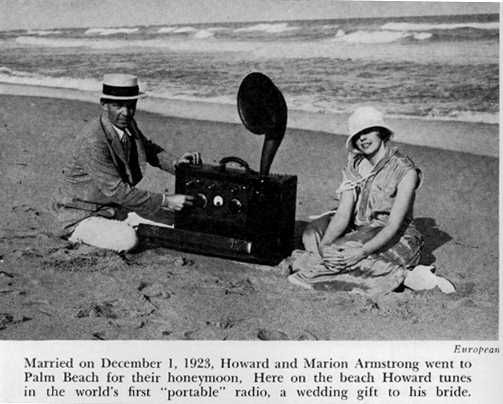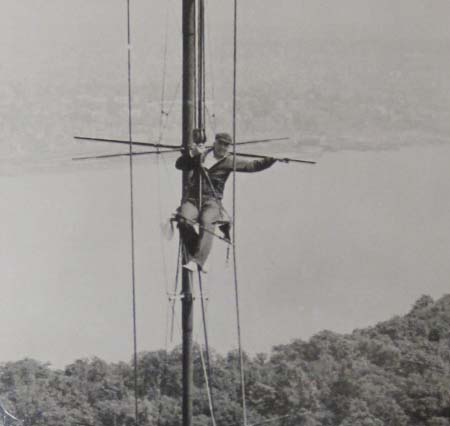Major Armstrong Speaks!
I’m sure you’ve all heard the tragic tale of Major Edwin Howard Armstrong? He was one of my Electrical Engineering heroes (including Tesla and Steinmetz). Here’s a brief (and possibly inaccurate) bio:
1. Invented several extremely key concepts in radio, including the regenerative detector and the super-hetrodyne receiver (all radios and TV’s use the super-hetrodyne circuit, even now!)
2. Served as a hero in WWI.
3. married David Sarnoff (CEO of RCA)’s secretary in 1923, drove to Palm Beach, Florida (in a new Hispano-Suiza!) for their honeymoon, where he gave his new bride the world’s first “portable” radio!
4. conducted years of experiments which led to his greatest invention (IMHO) … FM radio!
5. Along the way, he built a 400 foot tower in Alpine, NJ which (I’ll bet) almost all of us have seen.
By the way, this tower became re-famous when most of the New York TV stations were re-located there after the World Trade Center site was destroyed 9/11/2001.
6. Built the world’s first FM radio network (the Yankee Network)… with transmitters in Alpine, NY, Boston (Paxton) MA, Hartford, CT and on Mt. Washington, NH. This network covered most of the North-East. Each station relayed the broadcast of the other station, simply by relaying the high-quality FM signal from one of the other “chained” stations in the network. (just like NCPR!) People were lovin’ it, buying the new FM radios… life was great!
7. Not exactly…. David Sarnoff (president of RCA) (and others) perceived FM as a threat to their old-school AM radio networks (NBC, etc) So they “convinced” the FCC to eliminate the existing FM frequency band (42-50 mHz) which they needed for THEIR new invention… Television! 42-50 mHz was the never-used “Channel 1” by the way! Because all FM broadcasters were forced to move to the “new” FM band (88-109 mHz, where it is located now) all existing FM radios became immediately obsolete, as were all existing FM broadcasting stations (including Armstrong’s Yankee network). It took 25+ years for FM to recover (boosted by a 1966 FCC ruling which prohibited combination FM and AM stations from duplicating the AM programming on their FM station, opening up “niche” marketing formats, including the Alternative Rock formats from the late 60’s)
8. Meanwhile RCA used Armstrong FM patents for its new TV system… without paying a penny!
9. by 1954 Armstrong was broken physically and financially by years of fighting RCA for the rights to his FM patents, so he got dressed up in his coat and hat, removed the air conditioner from his 13th story window and took his final walk. Sarnoff remarked that “I did not kill Armstrong” .
10. Armstrong’s wife pursued the patent fight and eventually settled… AND she still had the Hispano-Suiza!
ANYWAY, my point is that I just discovered an audio recording made during better times, while Maj. Armstrong and his fellow engineers were first setting up the Yankee Network in 1941.
Imagine how we’re actually hearing this recording:
1) it was recorded directly from an FM radio in Connecticut on a “disc” (probably 78 RPM) recorder.
2) someone (the very “radio” sounding narrator) made a magnetic tape recording of the 78 rpm record probably in the 1950’s or 1960’s (judging by his voice, and the fact that he used the word “Megacycles” instead of the now used “Megahertz”)
3) this tape was played back into someone’s computer and digitized.
4) we can listen to it over the Internet, a HUGE network of glass fiber and computers.
ALSO, please check out the very interesting accents of the participants. Times have changed.
FINALLY… after all the fanfare, here’s the recording.











Great radio history lesson! More please.
Right on, Radio Bob! Armstrong was also my hero; the successful lone inventor aligned against the evil corporations.
In Iowa City, my family owned a Howard console radio/phonograph that included FM, purchased in 1941. Unfortunately, the nearest stations were in Chicago, about two hundred miles away. However, we regularly received east coast stations, including those mentioned on the recording.
What sticks in my memory about this early FM reception was the astonishing quality, including an absolutely quite background.
The most reliable reception occurred in August, because of meteor showers and/or temperature inversion. This potentially interfering propagation was used as one of the reasons to change the FM band from 42-50 MHz to 88-108. As a matter of fact, one summer during WWII, the FCC set up a monitoring station in Iowa City. The monitoring was of an east coast FM station operating in the existing band and an experimental station operating around 100 MHz. Halicrafters receivers were used, and although they could receive wide-band FM signals up to around 110 MHz, the receiver monitoring the higher frequency used an external one-tube converter to lower the frequency to something in the 42-50 MHz range. I don’t know why this was done; maybe something to do with receiver sensitivity. I still have the circuit of this converter.
When the FM band was exceptionally “hot,” I used to grab my Schwinn bicycle with two-speed New Departure coaster brake and gear shift and tear down to the monitoring station to see what they were getting.
Interestingly, the change in frequencies did not totally eliminate the so-called “skip” reception. During the summer, we sometimes get interference from FM stations in the Midwest.
What amazes me after being a broadcaster for over 20 years, is that you can take a non-linear amplifier, like a class C amp, and get great FM transmission out of it. Sure, I understand the theory and all, but how Armstrong came up with that, I’ll never know.
Thanks for sharing this Bob.
Hey Bob,
Interesting stuff, I’d been wondering lately about origins of radio broadcasting and how it got established. There must be a lot of work that was done between Marconi and the proliferation of stations and content that we assume always was. Not surprising that those with money delayed progress in their own self interest. There’s always lots of money available to keep things from changing.
How was it figured out that a buck could be made by broadcasting a signal that anyone with a reciever could get for free. Sort of like the internet and the rise of web pages?
Kent Gregson
I’m glad someone here at NCPR knows how to explain FM and AM technology and history. I knew we hired that Bob guy for a good reason…